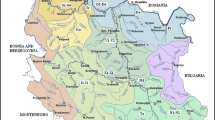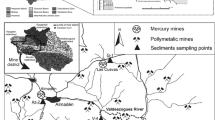Abstract
This study considers the effectiveness of the monitoring of toxic trace elements in various media from a polluted river estuary over a period of 15 years, using the same analytical techniques, facilities and, in some cases, the same operators. It shows that reliable comparisons can be made for monitoring waters, sediment and biota from the Derwent River Estuary between 1975 data and that from 1990. Rigorous studies were undertaken before and during 1975 to ensure that reliable data was achieved at that time. Such studies are reviewed and included the evaluation of digestion techniques for a range of heavy metals, specific attention to the reliability of mercury determination in sediments between laboratories, a comparison of direct calibration and standard addition techniques for metals in seawater, recoveries of an organomercury compound from fish, and sources of error arising from sample preparation of biota for subsequent metal analysis. Comparative results for standard reference materials in both 1975 and 1990 show good agreement and are considered reliable except for lead at low concentrations. The long-term retention of the analytical facilities permits a direct comparison of data from 2 monitoring programmes over the space of 15 years.
Similar content being viewed by others
References
Bloom, H.: 1975, ‘Heavy metals in the Derwent Estuary’, Chemistry Department, University of Tasmania, Hobart, Tasmania, 121 pp.
Bloom, H. and Ayling, G.M.: 1977, ‘Heavy metals in the Derwent Estuary’, Environ. Geol. 2, 3–22.
Bourg, A.C.M.: 1988, ‘Metals in Aquatic and Terrestrial Systems: Sorption, Speciation and Mobilisation’ in W. Salomons and U. Forstner (Eds.), Chemistry and Biology of Solid Waste: Dredged Material and Mine Tailings, Springer-Verlag Berlin/Heidelberg, pp. 3–32.
Director of Environmental Control: 1972, ‘Environmental pollution in Tasmania’, Report, Department of Environment, Tasmania, No. 74, 18 pp.
Director of Environmental Control: 1973, ‘Report for the Year 1972–1973’, Report, Department of Environment, No. 73, 19 pp.
Dix, T.G., Martin, A., Ayling, G.M., Wilson, K.C. and Ratkowsky, D.A.: 1975, ‘Sand Flathead (Platycephalus bassensis), an Indicator Species for Mercury Pollution in Tasmanian Waters’, Mar. Pollut. Bull. 6, 142–144.
Environment Protection Act: 1973, ‘The Determination of Total Mercury in Aqueous Samples by Flameless Atomic Absorption Spectrophotometry’, in The Code of Prescribed Methods of Sampling and Analysis Issued Under the Provisions of the ‘Environment Protection Act’, 1973, Tasmania, 6 pp.
Eustace, I.J.: 1974, ‘Zinc, Cadmium, Copper and Manganese in Species of Finfish and Shellfish Caught in the Derwent Estuary, Tasmania’, Aust. J. Mar. Freshwater Res. 25, 209–220.
McKay, T.R.: 1979, ‘Australian Inter-Laboratory Collaborative Studies on Analysis of Marine Environmental Pollutants’, paper presented at 5th Australian Symposium on Analytical Chemistry, 20–24 August, 1979, University of W.A., Perth, W.A.
Nix, J. and Goodwin, T.: 1970, ‘The Simultaneous Extraction of Iron, Manganese, Copper, Cobalt, Nickel, Chromium, Lead and Zinc from Natural Waters for Determination by Atomic Absorption Spectroscopy’, Atom, Absorb. Newsletter 9, 119–122.
Noller, B.: 1991, ‘Assessment of Trace Elements at Melville Bay, Gove Peninsula, Northern Territory’, Department of Mines and Energy, Darwin, Northern Territory, 70 pp.
Noller, B.N. and Bloom, H.: 1978, ‘Methods of Analysis for Major and Minor Elements in Foods’, Food Technol. Aust. (Jan.), 11–23.
Noller, B.N. and McKay, T.R.: 1990, ‘A Review of an Australian Inter- Laboratory/Inter-Operator Study on the Determination of Copper and Zinc in Some Marine Tissues’, in An Indo-Pacific Workshop on Analysis of Heavy Metals in Marine Samples — Validation and Quality Assurance. Report and Proceedings, 5–16 December, 1988, Curtin University of Technology, Perth, Western Australia, pp. 217–238.
Ratkowsky, D.A., Dix, T.G. and Wilson, K.C.: 1975, ‘Mercury in Fish in the Derwent Estuary, Tasmania, and Its Relation to the Position of the Fish in the Food Chain’, Aust. J. Mar. Freshwater Res. 26, 223–231.
Thrower, S.J. and Eustace, I.J.: 1973, ‘Heavy Metal Accumulation in Oysters Grown in Tasmanian Waters’, Food Technol. Aust. 25, 546–553.
Author information
Authors and Affiliations
Rights and permissions
About this article
Cite this article
Noller, B.N., Bloom, H., Dineen, R.D. et al. Effective monitoring of pollution by toxic trace elements in waters, sediment and biota of the Derwent River Estuary, Tasmania, through long-term retention of analytical facilities. Environ Monit Assess 28, 169–181 (1993). https://doi.org/10.1007/BF00547035
Received:
Revised:
Issue Date:
DOI: https://doi.org/10.1007/BF00547035




